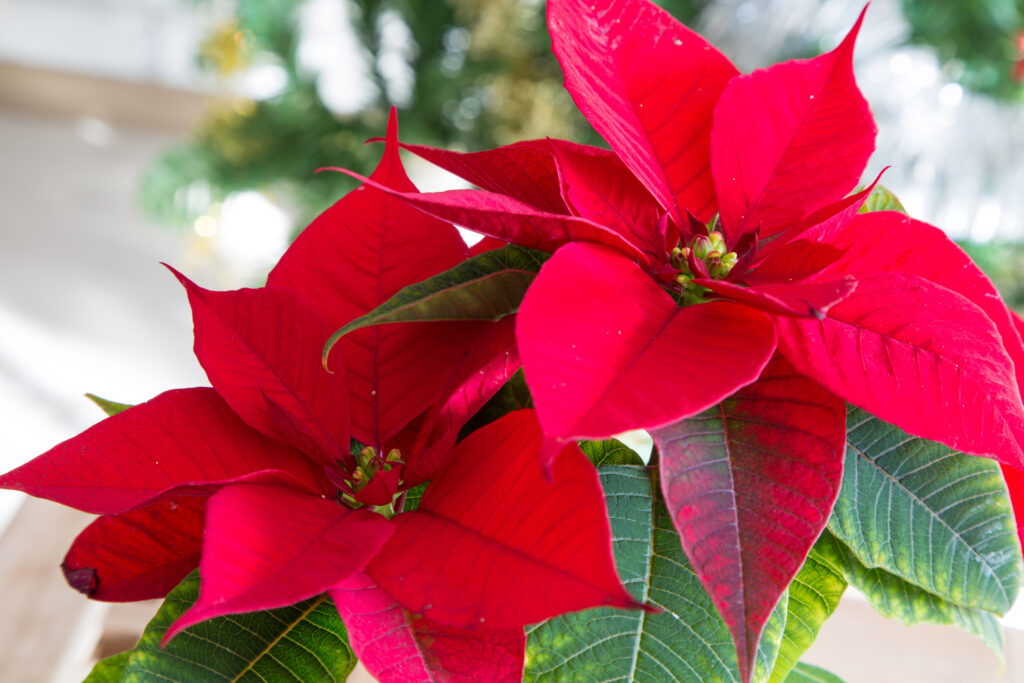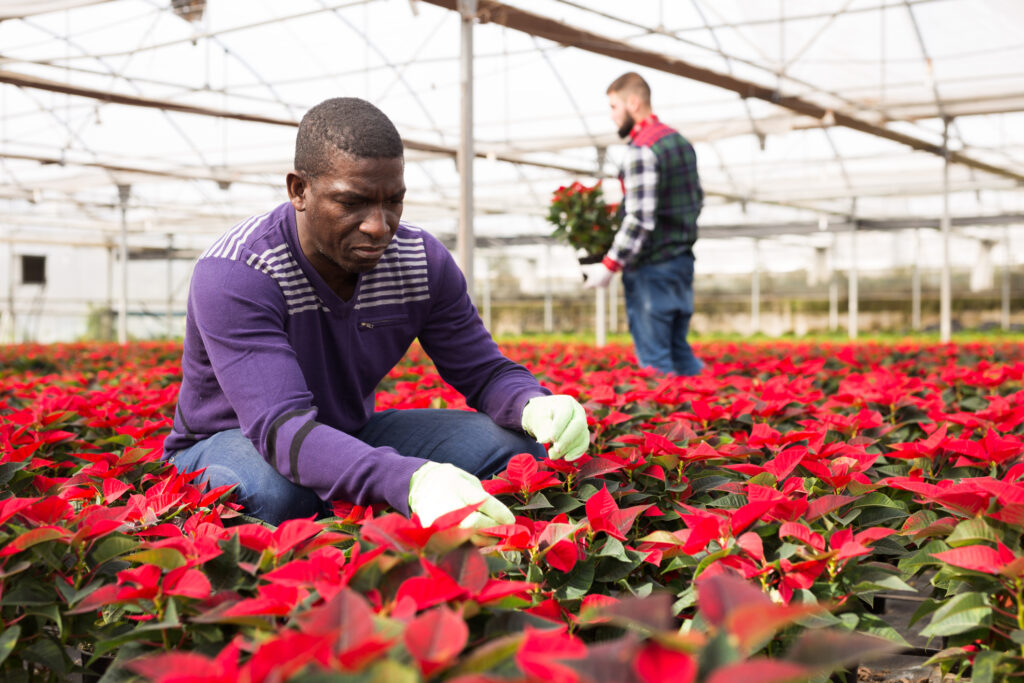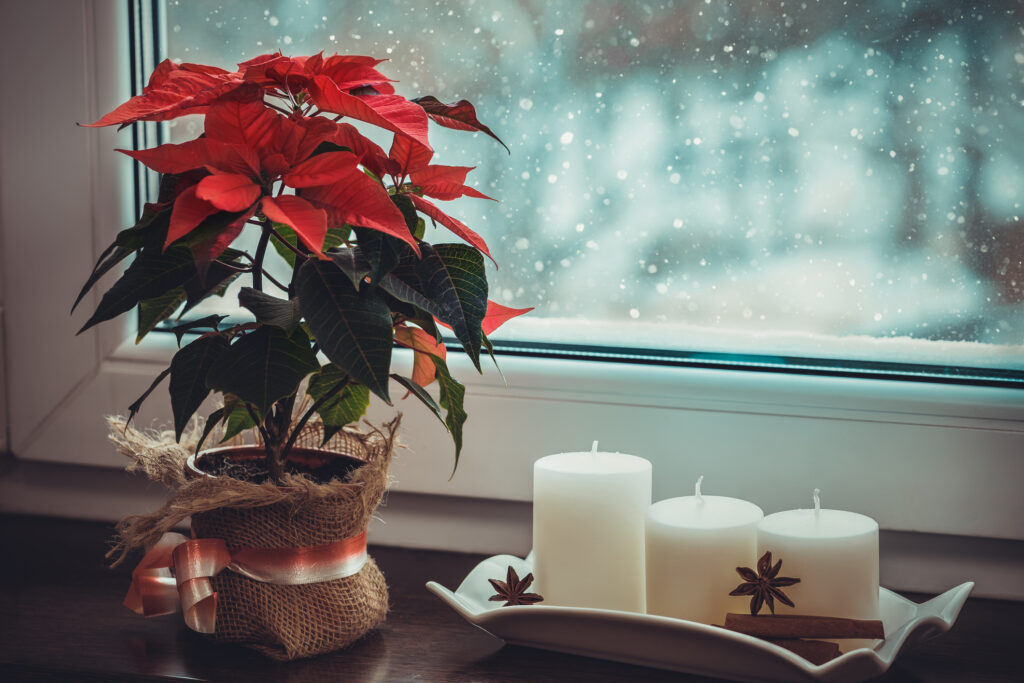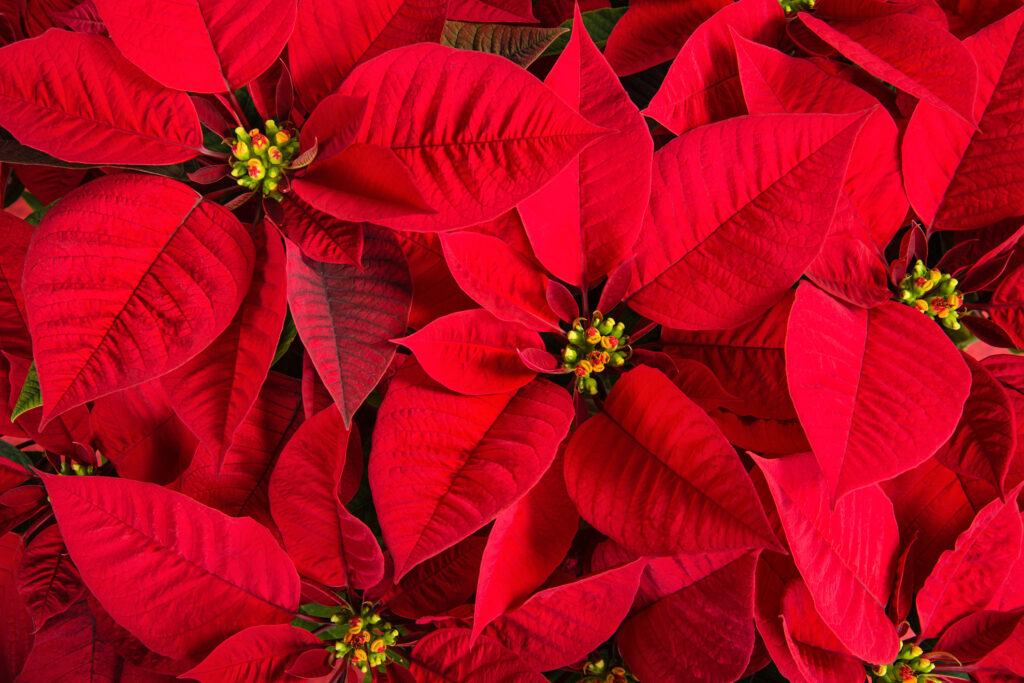
Updated: December 12, 2024
Poinsettias make an excellent holiday gift that, if treated properly, will hold their colorful bracts for many months, giving a long period of display. When given special care, poinsettia plants can be enjoyed for years to come.
In recent years, poinsettias have been hybridized to produce numerous varieties with different colored bracts and have become extremely popular holiday decorative plants. As outdoor garden plants in frost-free zones, poinsettias can grow up 3 feet tall or more and range in color from bright red to pink or white. As indoor, seasonal plants most will typically grow from 8 to 12 in. tall and wide. Some new varieties have bicolor or speckled bracts.
Poinsettia History

Poinsettias are native to Mexico and Central America, where they naturally grow as shrubs or small trees. Poinsettia flowers are small and greenish but are surrounded by brightly colored bracts (modified leaves) that have a long history of being used in decorating.
In the early 1800s, the first US ambassador to Mexico (who was an avid botanist and plant lover) Joel Roberts Poinsett brought poinsettia cuttings home and grew them in his South Carolina greenhouse. The plant’s common name “poinsettia” is a reference to Mr. Poinsett.
Poinsettia Fun Facts
- Poinsettias are in the Euphorbia (Spurge) family and are classified as Euphorbia pulcherrima.
- Poinsettias are not poisonous to humans, though some people may have an allergic, itching reaction from the sap if it touches their skin. Eating the leaves can cause an upset or irritated stomach and severe eye irritation from the sap is possible, so take caution to wash your hands well with soap and water after pulling leaves or touching poinsettia plants.
- December 12th is National Poinsettia Day in the US. This holiday honors Joel Roberts Poinsett, who introduced the poinsettia to the US and died December 12, 1851.
- Poinsettias are the top-selling potted plant in both the US and Canada. There are over 35 million poinsettias sold in the US each year.
- The Aztecs used poinsettias as a decoration, dye plant, and a medicinal herb.
Tips For Choosing & Transporting Your Poinsettia

Here are our recommendations for making your poinsettia perform at its best during the holiday season and beyond.
Choosing Your Poinsettia
By choosing a healthy plant, it will be easier to care for and helps to ensure your poinsettia will thrive for several seasons. Select a nicely proportioned plant with dark green leaves free from yellowing or curling. The bracts, which are the colored leaves around the flowers, should be fully colored and well-developed, with small yellow-green true flowers in the centers of the bracts.
Getting Your Poinsettia Home Safely
When taking poinsettias home from the store, it is important not to chill plants. If exposed to cold winds or temperatures of 50°F or below, poinsettias will be severely shocked and may drop their leaves. To prevent this, be sure the plant is in a large closed shopping bag, a box, or a paper or plastic sleeve made to protect the plant from the wind. Remove the protective cover and any decorative sleeves when plants are out of danger from cold.
Poinsettia Winter Care

Location
Place your poinsettia near a sunny window where they will get at least 6 to 8 hours of sunlight. South, west, or east-facing windows are best. If they do not get enough sun, the leaves lose their dark green color and start to drop. Do not let leaves touch window panes, as the cold temperatures can damage them.
The best temperature for poinsettias is 65 to 70°F during the day and 60 to 65°F at night. Avoid areas where plants will be exposed to sudden changes in temperature, such as near an outside door or near furnace vents.
Watering
It is very important to keep the soil evenly moist throughout the bloom period. If the soil is allowed to become overly dry and plants wilt between waterings, they will lose their leaves prematurely. Poinsettias are one of the few plants where moderate watering on a regular schedule is recommended and keeps plants at their best.

If you are not sure when to water, feel the soil. If the media at the top of the pot feels dry, water until it leaches out from the drain hole in the bottom of the pot. Discard all the excess water in the saucer below the pot to prevent oversaturating the soil. Average house humidity is fine for poinsettias, so they don’t need misting.
Water on colored poinsettia bracts can leave unsightly spots or spotting, so take care to not get water on the bracts. Wetting poinsettia leaves may also promote fungal disease that causes leaves to drop prematurely.
Fertilizing
Fertilization with an all-purpose liquid plant food like AlgoPlus 6-6-6 will prolong the life of your poinsettia. Use a low rate of fertilizer every two weeks while the plant is blooming. A good rule of thumb is to use 1/2 to 1/3 of the recommended fertilizer rate.
The last thing to remember is to not remove the greenish-yellow true flowers that grow in the centers of the bracts. If the flowers are removed, the bracts will quickly fade.
After Holiday Care

People are often interested in keeping poinsettias alive and reblooming them for the following Christmas. This can be done with some care, though blooming may not be as full as it was initially. To keep plants in good shape, put them in a sunny location and feed them with soluble plant food once every two to three weeks according to label directions.
When the bracts begin to fade, usually in late February to early March, cut the stems back to about 6 inches tall. This will cause branching near the base which helps to keep plants more stocky. If you have sensitive skin, wear gloves to avoid contact with the milky sap produced when cutting the stems.
After cutting back, give poinsettias a short rest by discontinuing fertilizing and reducing watering for about 4 weeks. You may resume use of a full-strength, all-purpose fertilizer every 2 to 3 weeks after the rest period.
Poinsettia Summer Care

Transplanting
In early summer, transplant your poinsettia plant to a new pot that is about 1 to 2 inches larger in diameter than the pot it is currently in. Use new, fresh well-draining potting soil. Transplanting promotes new root growth and should be done even if new shoots are growing. If the plant is rootbound, gently break up or cut the edges of the root ball to allow new roots to grow. Fertilize the newly transplanted poinsettia and pinch it lightly once growth begins.
Hardening Off Period
Just like with young vegetable plants, poinsettias should be hardened off for their transition from inside to outside. Gradually expose plants to full sunshine, keeping them initially in a lightly shaded spot, introducing them to more sun exposure gradually over a two-week period. Once plants are moved outside permanently, keep them watered and fertilized throughout the summer.
Poinsettias will prefer a sunny location but need soil that is kept evenly moist, but well-drained. To reduce their need for frequent watering, pots can be buried in garden beds.
Pinching
Pinch plants again in August to promote branching. This should be the last time you pinch back the plant before flowering.
Cool Weather
Bring poinsettias indoors before cool autumn nights begin. If exposed to cool temperatures, plants can be damaged and many not flower.
Insect Control
Inspect plants for insects before bringing them indoors. The most common insect problem is the whitefly. They can be spotted by brushing the leaves with your hand. If small white insects fly from the plant, these are whiteflies. Whitefly can be controlled with insecticidal soap. Several applications may be necessary to completely eliminate the pest. Always read and follow all label directions when using pesticides.
Produce Colored Bracts
Poinsettias need a period of short days and long nights to produce bracts. Start a short-day treatment in mid to late September to produce color around Christmas.
It takes 8 to 10 weeks of nights with at least 14 hours of complete darkness to initiate bracts. To provide short days, move poinsettias into a room that has no artificial light at night, or place a cardboard box or black plastic bag over the plant each night. Be sure the temperature will not fall below 65°F. Each morning, the plant must be placed in a sunny window again. Continue this treatment every day for at least 8 weeks or until small bracts develop. Once bracts appear, you can discontinue their long night treatments.
Maintain fertilizer for every two to three weeks with AlgoPlus all-purpose 6-6-6 and keep plants evenly moist throughout the flowering period.
There is no other plant that epitomizes our sense of the Christmas season. Give a poinsettia plant to a friend, a neighbor, or bring one with you to your family holiday meal or to share with your congregation. A poinsettia, as a gift, is a symbol of the Christmas spirit. An honest, simple, and profound symbol of spirit and love for all humanity.
Other Recommended Reading


At Jung Seed Co, we strive to be your go-to guide for all your gardening needs. Our YouTube channel, The Garden Doctor by Dick Zondag, is where he provides gardening tips for all levels of gardeners. When you need reliable gardening advice, turn to the trusted experts at Jung.
View our new catalog online or browse our website for your gardening favorites. Sign up for our weekly email to receive info on new products, exclusive deals, and specials. Join our Facebook page to discuss all things gardening!